Buffalo, New York, Hgh State Clinic, Hgh Injections, Hrt Doctors
Buffalo, New York Blood Testing Facilities
 Represents a LabCorp blood testing facility
Represents a LabCorp blood testing facility Represents a Quest Diagnostics blood testing facility
Represents a Quest Diagnostics blood testing facility
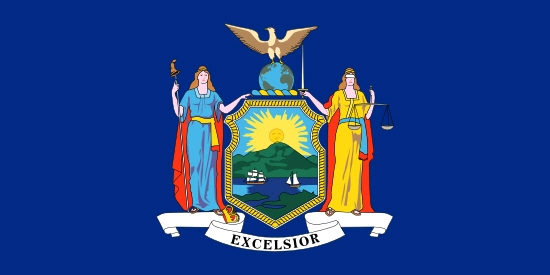
Nearby Labcorp Blood Testing facilities:
- Labcorp Center Distance: 7 m, 4500 Main St, Amherst, Erie County, NY, 14226
- Labcorp Center Distance: 12 m, 9095 Main St Ste A, Clarence, Erie County, NY, 14031
- Labcorp Center Distance: 49 m, 117 Main Street, Randolph, Cattaraugus County, NY, 14772
- Labcorp Center Distance: 57 m, 15 South Main Street, Jamestown, Chautauqua County, NY, 14702
- Labcorp Center Distance: 58 m, 110 Mall Blvd, Lakewood, Chautauqua County, NY, 14750
- Labcorp Center Distance: 80 m, 300 State Street Suite 303, Erie, Erie County, PA, 16507
Nearby Quest Blood Testing facilities:
- Quest Center Distance: 1 m, 455 Delaware Ave, Buffalo, Erie County, NY, 14202-1514
- Quest Center Distance: 2 m, 1317 Jefferson Ave, Buffalo, Erie County, NY, 14208-2102
- Quest Center Distance: 4 m, 155 Lawn Ave, Buffalo, Erie County, NY, 14207-1816
- Quest Center Distance: 5 m, 264 Center Rd, West Seneca, Erie County, NY, 14224-1947
- Quest Center Distance: 6 m, 1106 Union Rd, West Seneca, Erie County, NY, 14224-3450
- Quest Center Distance: 7 m, 4041 Delaware Ave, Tonawanda, Erie County, NY, 14150-6850
- Quest Center Distance: 8 m, 3041 Orchard Park Rd, Orchard Park, Erie County, NY, 14127-1208
- Quest Center Distance: 9 m, 3674 Commerce Place, Hamburg, Erie County, NY, 14075-3664
- Quest Center Distance: 10 m, 1150 Youngs Rd, Williamsville, Erie County, NY, 14221-8053
- Quest Center Distance: 11 m, 301 Meadow Dr, North Tonawanda, Niagara County, NY, 14120-2819
- Quest Center Distance: 14 m, 268 Main St, East Aurora, Erie County, NY, 14052-1637
- Quest Center Distance: 15 m, 1370 Military Rd, Niagara Falls, Niagara County, NY, 14304-1730
- Quest Center Distance: 17 m, 742 Portage Rd, Niagara Falls, Niagara County, NY, 14301-1924
- Quest Center Distance: 18 m, 12845 Broadway St, Alden, Erie County, NY, 14004-1223
- Quest Center Distance: 19 m, 5891 S Transit Rd, Lockport, Niagara County, NY, 14094-6305
- Quest Center Distance: 21 m, 755 Center St, Lewiston, Niagara County, NY, 14092-1756
- Quest Center Distance: 27 m, 231 S. Cascade Dr, Springville, Erie County, NY, 14141-0000
- Quest Center Distance: 29 m, 2735 Main St, Newfane, Niagara County, NY, 14108-1203
- Quest Center Distance: 36 m, 312 Central Avenue, Dunkirk, Chautauqua County, NY, 14048-2125
- Quest Center Distance: 52 m, 193 East Main Street, Westfield, Chautauqua County, NY, 14787-1104
- Quest Center Distance: 58 m, 759 Foote Avenue, Jamestown, Chautauqua County, NY, 14701-9582
- Quest Center Distance: 67 m, 2060 North Pearl Street, North East, Erie County, PA, 16428-1926
- Quest Center Distance: 75 m, 4916 Buffalo Road, Erie, Erie County, PA, 16510-2304
- Quest Center Distance: 78 m, 2020 East 38Th Street, Erie, Erie County, PA, 16510-3607
- Quest Center Distance: 80 m, 1526 Peach St, Erie, Erie County, PA, 16501-2110
- Quest Center Distance: 82 m, 3315 Liberty Street, Erie, Erie County, PA, 16508-2558
- Quest Center Distance: 83 m, 2501 West 12Th Street, Erie, Erie County, PA, 16505-4527
- Quest Center Distance: 84 m, 7200 Peach St, Erie, Erie County, PA, 16509-4754
- Quest Center Distance: 86 m, 4247 West Ridge Rd, Erie, Erie County, PA, 16506-1718
- Quest Center Distance: 88 m, 991 Route 19, Waterford, Erie County, PA, 16441-9739
- Quest Center Distance: 94 m, 5165 Imperial Pkwy, Girard, Erie County, PA, 16417-9523
Buffalo Hormone Replacement Therapy Services
Hormone Optimization is one of the newest forms of health and wellness therapy, and it's taking the United States by storm. Aging is the result of many factors, and as medical researchers continue to try to answer the questions of how and why we age, they are learning that one of the factors which hastens the aging process is Hormone Imbalance and Deficiency. One of the keys to maintaining a healthy body and mind is to foster hormone balance, but, unfortunately, the body loses its ability to adequately produce many of the hormones which help us maintain ourselves at our functional peak, including Human Growth Hormone and Testosterone.
The Conscious Evolution Institute is a licensed and board certified Hormone Clinic that proudly serves the Buffalo Metropolitan area. Whether you live in Kenmore or Amherst, West Seneca or Blasdell, we have affiliate Hormone Specialists that can be your gateway to the quality HRT Products and Services that you've been looking for!
Buffalo Testosterone Replacement Therapy for Andropause and Low-T
Low-T is one of the most prevalent Age-Related Hormone Deficiencies in the United States, and millions of men suffer not only in the bedroom, but in their day-to-day lives as a result of this affliction. Testosterone Deficiency is most well-known for draining sex drive and leading to erectile dysfunction, but it also leads to a variety of other symptoms which impede health and wellness. It leads to weight get and loss of strength, reduced muscle mass and strength, increased anxiety, reduced confidence, and depression, in addition to poor cholesterol, atherosclerosis, and hypertension.
We offer Buffalo Testosterone Treatments such as Low-T Patches, Injections, and Creams, designed to foster healthier Testosterone Levels, helping you overcome the risks associated with Testosterone Deficiency, and hopefully allowing you to live a longer and healthier life.
Buffalo Growth Hormone Shots for HGH Restoration
Another important Hormone that must be balanced in order to maintain wellness is Human Growth Hormone. HGH is sensitive to poor habits such as bad diet, poor sleep, and sedentary lifestyle, but it is also sensitive to the aging process. If you have noticed physiological changes as you pass the age of thirty that relate to energy level, heart health, psychological and cognitive well-being, or BMI, you may be a candidate for HGH Therapy from a licensed Buffalo Hormone Clinic. By restoring HGH levels to those associated with early adulthood, it is possible to ease the symptoms of aging exacerbated by Hormone Imbalance and decline, improving your health and well-being.
Buffalo Sermorelin Acetate Quality Alternative to Human Growth Hormone Therapy
Bio-Identical HGH Injections are not the only option available for patients suffering from Human Growth Hormone Deficiency, however. Another option available to patients is Recombinant Sermorelin Therapy. Sermorelin is a clinically-produced derivitive of a natual hormone known as GH-RH, which has the same effects on human physiology as its parent hormone. Sermorelin promotes healthy HGH Levels by stimulating the human pituitary to produce the necessary levels of Growh Hormone to restore those levels to that of early adulthood. Contact our Buffalo HGH Doctors to find out more about the pros and cons of Sermorelin vs. Human Growth Hormone.
Buffalo HCG Weight Loss Shots for Rapid Weight Loss
Bio-Identical HCG is a naturally-derived Hormone Treatment that has been shown to produce some very special benefits to the human body. One of th emany uses of HCG is to encourage weight loss in patients that are overweight or obese. Caloric Restriction, combined with regular HCG Injections, can help patients lose as much as thirty pounds each month, without succumbing to overwhelming cravings for junk food or hunger which makes the diet unpleasant. In addition to this, HCG helps promote normalized energy levels and body composition by encouraging the metabolism of bodyfat over lean muscle. If you are interested in Buffalo HCG Injection Therapy, we can arrange for a meeting with an HRT Specialist in the Buffalo area.
Buffalo New York Information
Buffalo is located on the eastern coast of Lake Erie, just across the United States border from Canada. The premier attraction in the Buffalo area is Niagara Falls, which forms a natural border between the two countries. Buffalo has two major professional sports teams: the Buffalo Sabres of the National Hockey League and the Buffalo Bills of the National Football League. Buffalo is referred to by a number of nicknames, including the City of Light, the Queen City of the Lakes, and the City of Good Neighbors.
The economy of Buffalo was once dominated by manufacturing, but as the economic landscape changed in the mid-20th century, the city's prosperity fell into decline. Today, the Buffalo economy is in the process of rebuilding itself, and is doing well by entering a state of diversification common among many of the nation's most stable cities. Among the largest employers in Buffalo are Tops Markets, the University of Buffalo, M&T Bank, Kaleida Health, and the local, state, and federal public sector.
All About Buffalo, New York Geographic Area
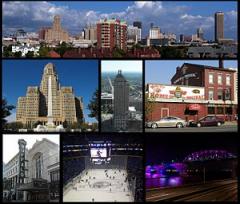
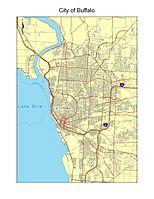
Buffalo ( /ËnbÊufÉoloÊo/) is the second most populous city in the state of New York, after New York City. Located in Western New York on the eastern shores of Lake Erie and at the head of the Niagara River across from Fort Erie, Ontario, Buffalo is the seat of Erie County and the principal city of the Buffalo-Niagara Falls metropolitan area, the largest in Upstate New York. Buffalo itself has a population of 261,310 (2010 Census) and the Buffalo aeNiagara aeCattaraugus Combined Statistical Area is home to 1,215,826 residents.
/ËnbÊufÉoloÊo/) is the second most populous city in the state of New York, after New York City. Located in Western New York on the eastern shores of Lake Erie and at the head of the Niagara River across from Fort Erie, Ontario, Buffalo is the seat of Erie County and the principal city of the Buffalo-Niagara Falls metropolitan area, the largest in Upstate New York. Buffalo itself has a population of 261,310 (2010 Census) and the Buffalo aeNiagara aeCattaraugus Combined Statistical Area is home to 1,215,826 residents.
Originating around 1789 as a small trading community near the eponymous Buffalo Creek, Buffalo grew quickly after the opening of the Erie Canal in 1825, with the city as its western terminus. By 1900, Buffalo was the 8th largest city in the United States, and went on to become a major railroad hub, and the largest grain-milling center in the country. The latter part of the 20th century saw a reversal of fortunes: Great Lakes shipping was rerouted by the opening of the St. Lawrence Seaway, and steel mills and other heavy industry relocated to places such as China. With the start of Amtrak in the 1970s, Buffalo Central Terminal was also abandoned, and trains were rerouted to nearby Depew, New York (Buffalo-Depew) and Exchange Street Station. By 1990 the city had fallen back below its 1900 population levels.
Today, the region's largest economic sectors are health care and education, and these continue to grow despite the lagging national and worldwide economies. This growth has been maintained, in part, by major expansions of the Buffalo Niagara Medical Campus and the University at Buffalo, The State University of New York. The retail sector of Buffalo's economy has remained strong throughout the economic recession due to additional revenue from Canadian shoppers who wish to take advantage of lower prices and taxes on the American side of the border. A recent study found Buffalo's August 2011 unemployment rate to be 7.3% In 2010, Forbes rated Buffalo the 10th best place to raise a family in America.
In 1798, The Holland Land Company hired Theophile Cazenove of Philadelphia as its agent in the newly established hub for the area in nearby Batavia, NY. Cazenove then hired Joseph Ellicott, to survey the area and establish a village next to Buffalo Creek. Ellicott decided to utilize the spoke pattern for his new village, which he called "New Amsterdam", and centered it around Niagara Square. In 1800, residents of the small village decided they did not like the name "New Amsterdam" and decided it would be called "Buffalo". In 1808, the name was officially changed and the Village of Buffalo had 25 residents at the time.
The earliest name origin theory to appear in print (1825) relates a story about stolen horsemeat being passed off as bison flesh, with the site of the illicit picnic henceforth remembered as "Buffalo," but the author who conveyed this tale expressed his skepticism.
While much current popular opinion seems to be that the city of Buffalo could not be named after the animal so representative of North America because there were no buffalo [bison] in the area or in eastern North America in general, it seems probable from historical evidence of the large impression made by eastern buffalo on early eastern explorers that the city was in fact named after the animal, and that buffalo were widespread and well known in eastern North America, including the area of the current city of Buffalo. There is much evidence from historical accounts of early European explorers described in the 1889 book "The Extermination Of The American Bison" by William T. Hornaday (superintendent of the former National Zoological Park) that bison were present along the shores of Lake Erie very near, if not within, the current location of the city of Buffalo, and that bison were found as far east as the eastern seaboard. Bison were familiar to and exclaimed about in writing by the earliest European explorers of most of the eastern seaboard and, later, noted in writing by explorers of most of the interiors of the present great lakes states east of the Mississippi as well as of most eastern seaboard states. In addition, Father Hennipin included an unmistakable drawing and description of a bison in a wooded setting from his 1698 book "A New Discovery Of A Vast Country In America" (reproduced in "The Atlas Of North American Exploration - From The Norse Voyages To The Race For The Poles" by William H. Goetzmann & Glyndwar Williams, 1992) describing his travels through the current city of Buffalo area during which his party discovered Niagara Falls, located very near Buffalo.
The closest of the first French or English forts to the current location of the city of Buffalo (other than Fort Niagara) was the French Fort Le Boeuf, which was an inland fort located on a river flowing into Lake Erie in western Pennsylvania, east of Erie and near the current NY border. Fort Le Boeuf existed from 1753 to 1759 and was at the western boundary of the immense, virtually unsettleable (by Europeans) Iroquois country (very hostile and still unsubdued by Europeans) which included at its western end the current location of Buffalo. Many current cities and counties in the great lakes region take their names from former English or French frontier forts of this era in the great lakes region. Fort Le Boeuf can be translated to "Fort Buffalo" since it is believed that the name "buffalo" originated with the French fur trappers who called the American bison "boeufs", meaning ox or bullock. Since the names of geographical locations in these early times of settlement seem to frequently migrate to nearby areas or be otherwise spatially and temporally indistinct or general, in part due to uncertainties and inaccuracies in early maps and lack of settlement, it is not implausible that the city of Buffalo derived its name directly or indirectly from Fort Le Boeuf.
Buffalo River may have been named before the city of Buffalo, with the city of Buffalo deriving its name from that river, Buffalo Creek; as Buffalo Creek first appeared on a map in 1759 ae1760. ". Therefore, the first known written use of the word "Buffalo" in the area of the current city of Buffalo occurred at precisely the time in which Fort Le Boeuf ceased its six years of operations. The Buffalo River may therefore simply inherited the nearby fort's place-name on maps, with appropriate translation to English, desired because the usual translation of Le Boeuf to "ox" would have lost the desired unique American connotation possessed by the word "buffalo".
In any event, confusion about the existence of bison in the Buffalo area despite widespread initial descriptions of bison by the earliest explorers in most areas east of the Mississippi may have resulted because reference to bison in the area indeed seem to end before widespread European settlement and the establishment of the city of Buffalo, perhaps due to the advance of European weaponry to the eastern Indians before the advance of European settlements. However, by the time of the establishment of the city of Buffalo, bison (known then popularly as buffalo) had already been established as a spectacular and representative North American animal in the minds of people involved in renaming the city of Buffalo, and a history of naming nearby settlements and locations for the animal had been established even when those settlements were not connected in any way with any landmarks or events unique to the city of Buffalo.
It is therefore likely that Buffalo was directly or indirectly named after the common term for bison, even if the naming was purely historical in the sense that the city was named at a time the animal was probably extirpated in the city's locale, and although Fort Le Boeuf had ceased operation a generation earlier.
A currently popular account also holds that the name "Buffalo" is a corruption of the French phrase beau fleuve, "beautiful river," a phrase said to have been exclaimed by French explorers upon seeing the Niagara River. This speculation, however, is contradicted by primary sources. French explorers actually referred to Buffalo Creek in print as Riviere aux Chevaux, "Horse River."
However, without additional historical discoveries, it is unlikely that an indisputable historical thread can be established leading to the city of Buffalo's naming.


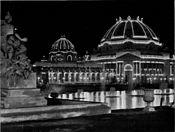
Prior to the Iroquois occupation of the region, the region was settled by the Neutral Nation. Later, the Senecas of the Iroquois Confederacy conquered the Neutrals. In 1804, Joseph Ellicott, a principal agent of the Holland Land Company, designed a radial street and grid system that branches out from downtown like bicycle spokes. During the War of 1812, on December 30, 1813,' Buffalo was burned by British forces. On November 4, 1825 the Erie Canal was completed with Buffalo strategically positioned at the western end of the system. At the time, the population was about 2,400. The Erie Canal brought a surge in population and commerce which led Buffalo to incorporate as a city in 1832, with a population of about 10,000 people.
The City of Buffalo has long been home to African-Americans. An example is the 1828 village directory which listed 59 "Names of Coloured" heads of families. In 1845, construction was begun on the Macedonia Baptist Church (commonly called the Michigan Street Baptist Church). This African-American church was an important meeting place for the abolitionist movement. On February 12, 1974 the church was added to the National Register of Historic Places. Abolitionist leaders such as William Wells Brown made their home in Buffalo. Buffalo was also a terminus point of the Underground Railroad with many fugitives crossing the Niagara River from Buffalo to Fort Erie, Ontario and freedom.
During the 1840s, Buffalo's port continued to develop. Both passenger and commercial traffic expanded with some 93,000 passengers heading west from the port of Buffalo. Grain and commercial goods shipments led to repeated expansion of the harbor. In 1843, the world's first steam-powered grain elevator was constructed by local merchant Joseph Dart, Jr. and engineer Robert Dunbar. The "Dart Elevator" enabled faster unloading of lake freighters along with the transshipment of grain in bulk from lakers to canal boats and, later on, rail cars.
Abraham Lincoln visited Buffalo on February 16, 1861 on his trip to accept the presidency of the United States. During his visit, he stayed at the American Hotel on Main Street between Eagle Street and Court Street. The Civil War years saw an increase in the population of Buffalo which grew from 81,029 to 94,210 by 1865. In addition to sending many soldiers to the Union effort, Buffalo manufacturers supplied important war material. For example, the Niagara Steam Forge Works manufactured turret parts for the ironclad ship USS Monitor.
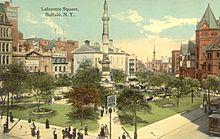
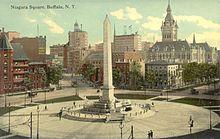
Grover Cleveland served as Sheriff of Erie County (1871 ae1873), and was Mayor of Buffalo in 1882. He was later Governor of New York (1883 ae1885), 22nd President of the United States (1885 ae1889) and 24th President (1893 ae1897).
In May 1896, the Ellicott Square Building opened. For the next 16 years, it was the largest office building in the world. It was named after the surveyor Joseph Ellicott.
At the dawn of the 20th century, local mills were among the first to benefit from hydroelectric power generated via the Niagara River. The city got the nickname City of Light at this time due to the widespread electric lighting. In 1881, Buffalo deployed the first electric street lights in the United States. It was also part of the automobile revolution, hosting the brass era car builders Pierce Arrow and the Seven Little Buffaloes early in the century. City of Light (1999) was the title of Buffalo native Lauren Belfer's historical novel set in 1901, which in turn engendered a listing of real versus fictional persons and places featured in her pages.
President William McKinley was shot and mortally wounded at the Pan-American Exposition in Buffalo on September 6, 1901. He died in the city eight days later and Theodore Roosevelt was sworn in at the Wilcox Mansion as the 26th President of the United States.
An international bridge, known as the Peace Bridge, linking Buffalo to Fort Erie, Ontario was opened in 1927. The Buffalo Central Terminal, a 17-story Art Deco style station designed by architects Fellheimer & Wagner for the New York Central Railroad, was finished just weeks before the Wall Street Crash of 1929.
During World War II, Buffalo saw a period of prosperity and low unemployment due to its position as a manufacturing center. The American Car and Foundry company, which manufactured railcars, reopened their Buffalo plant in 1940 to manufacture munitions during the war years.
With the opening of the St. Lawrence Seaway in 1957, which cut the city off from valuable trade routes; deindustrialization; and the nation-wide trend of suburbanization; the city's economy began to deteriorate. Like much of the Rust Belt, Buffalo, which peaked at more than half a million people in the 1950s, has seen its population decline by almost 50 percent as industries shut down and people left for the suburbs or other cities.
Like other rust belt cities such as Flint, Michigan, Buffalo has attempted to revitalize its beleaguered economy and crumbling infrastructure. In the first decade of the 21st century, a massive increase in economic development spending has attempted to reverse its dwindling prosperity. $4 billion was spent in 2007 compared to a $50 million average for the previous ten years. New proposals and renovations are numerous, especially in the downtown core. As of 2008, the population has continued to decrease, despite the efforts of city officials. (See demographics section.)
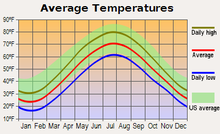
Buffalo is located on the eastern end of Lake Erie, opposite Fort Erie, Ontario, and at the beginning of the Niagara River, which flows northward over Niagara Falls and into Lake Ontario.
According to the United States Census Bureau, the city has a total area of 52.5 square miles (136 km2), of which 40.6 square miles (105 km2) is land and 11.9 square miles (31 km2) is water. The total area is 22.66% water.
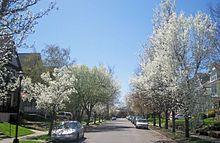
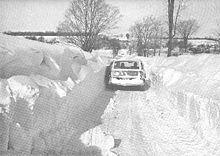
Buffalo has a reputation for snowy winters, but it is rarely the snowiest city in New York State. The region experiences a fairly humid, continental-type climate, but with a definite maritime flavor due to strong modification from the Great Lakes (Koppen climate classification "Dfb" ae uniform precipitation distribution). The transitional seasons are very brief in Buffalo and Western New York.
Winters in Western New York are generally cold and snowy, but are changeable and include frequent thaws and rain as well. Winters can also be quite long in Western New York, usually spanning from mid-November to mid-March. Snow covers the ground more often than not from late December into early March, but periods of bare ground are not uncommon. Over half of the annual snowfall comes from the lake effect process and is very localized. Lake effect snow occurs when cold air crosses the relatively warm lake waters and becomes saturated, creating clouds and precipitation downwind. Due to the prevailing winds, areas south of Buffalo receive much more lake effect snow than locations to the north. The lake snow machine starts as early as mid-November, peaks in December, then virtually shuts down after Lake Erie freezes in mid-to-late January. The most well-known snowstorm in Buffalo's history, the Blizzard of '77, was not a lake effect snowstorm in Buffalo in the normal sense of that term (Lake Erie was frozen over at the time), but instead resulted from a combination of high winds and snow previously accumulated both on land and on frozen Lake Erie. Snow does not typically impair the city's operation, but can cause significant damage as with the October 2006 storm.
Buffalo has the sunniest and driest summers of any major city in the Northeast, but still has enough rain to keep vegetation green and lush. Summers are marked by plentiful sunshine and moderate humidity and temperature. It receives, on average, over 65% of possible sunshine in June, July and August. Obscured by the notoriety of Buffalo's winter snow is the fact that Buffalo benefits from other lake effects such as the cooling southwest breezes off Lake Erie in summer that gently temper the warmest days. As a result, the Buffalo station of the National Weather Service has never recorded an official temperature of 100 °F (37.8 °C) or more. Rainfall is moderate but typically occurs at night. The stabilizing effect of Lake Erie continues to inhibit thunderstorms and enhance sunshine in the immediate Buffalo area through most of July. August usually has more showers and is hotter and more humid as the warmer lake loses its temperature-stabilizing influence.
The highest recorded temperature in Buffalo was 99 °F (37.2 °C) on August 27, 1948, and the lowest recorded temperature was na20 °F ( na28.9 °C) on February 9, 1934 and February 2, 1961.
Like most formerly industrial cities of the Great Lakes region, Buffalo has experienced an economic depression brought about by the loss of its industrial base. The city's population peaked in 1950, when it was the 15th largest city in the United States and its population has declined every census since then. The demographic change and the impact of such change on the industrial cities of the region, including Buffalo, is significant; based on the 2006 US Census estimate, Buffalo's current population is equivalent to its population in the year 1890, reversing 120 years of demographic change.
Although the trend is inconclusive at this time, current census estimates indicate the rate of population loss may be decelerating to a stable state. The 2008 ae2009 loss estimate is 50% less than the years prior, and is at less than 1% year-over-year loss. Whether this trend will continue will not be evident until next year's estimate.
At the 2010 Census, the city's population was 50.4% White (45.8% non-Hispanic White alone), 38.6% Black or African American, 0.8% American Indian and Alaska Native, 3.2% Asian, 3.9% from some other race and 3.1% from two or more races. 10.5% of the total population was Hispanic or Latino of any race.
At the time of the 2000 census there were 292,648 people, 122,720 households, and 67,005 families residing in the city. The population density is 7,205.8 people per square mile (2,782.4/km ²). There are 145,574 housing units at an average density of 3,584.4 per square mile (1,384.1/km ²). The racial makeup of the city is 54.43% White, 37.23% African American, 0.77% Native American, 1.40% Asian, 0.04% Pacific Islander, 3.68% from other races, and 2.45% from two or more races. 7.54% of the population are Hispanic or Latino of any race. The top 5 largest ancestries include German (13.6%), Irish (12.2%), Italian (11.7%), Polish (11.7%), and English (4.0%).
There were 122,720 households out of which 28.6% have children under the age of 18 living with them, 27.6% are married couples living together, 22.3% have a female householder with no husband present, and 45.4% are non-families. 37.7% of all households are made up of individuals and 12.1% have someone living alone who is 65 years of age or older. The average household size is 2.29 and the average family size is 3.07.
In the city the population included 26.3% under the age of 18, 11.3% from 18 to 24, 29.3% from 25 to 44, 19.6% from 45 to 64, and 13.4% who are 65 years of age or older. The median age is 34 years. For every 100 females there are 88.6 males. For every 100 females age 18 and over, there are 83.5 males.
The median income for a household in the city is $24,536, and the median income for a family is $30,614. Males have a median income of $30,938 versus $23,982 for females. The per capita income for the city is $14,991. 26.6% of the population and 23.0% of families are below the poverty line. Out of the total population, 38.4% of those under the age of 18 and 14.0% of those 65 and older are living below the poverty line.
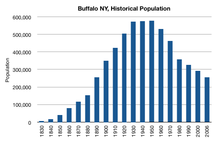
Buffalo has very sizable populations of Irish, Italian, Polish, German, Jewish, Greek, Arab, African American, Indian, and Puerto Rican descent. Major ethnic neighborhoods still exist but they changed significantly in the second half of the 20th century. In 1940, non-Hispanic whites were 96.8% of the city's population. Traditionally, Polish-Americans were the predominant occupants of the East Side, while Italian-Americans composed a close-knit neighborhood in the west side. The East Side is now a predominantly African American neighborhood, while the West Side has become a melting pot of many ethnicities, with Latino culture being the strongest influence. Throughout the history of Buffalo, the neighborhoods collectively called the First Ward, as well as much of South Buffalo, have comprised almost entirely people of Irish descent. Recently, there has been an influx of inhabitants that are of Arab descent, mainly from Yemen, as the city's Muslim population has increased to approximately 3000 according to an estimate. Since the 1950s and 1960s, the greater portion of the Jewish population has moved to the suburban areas outside of the city, or to the city's upper West Side.
As of 2006, Erie and Niagara Counties had a combined estimated population of 1,154,378. The racial makeup of the area is 82.2% White, 13% African American, 0.6% Native American, 1.32% Asian, 3.3% Hispanic, and 1.4% of all other races. In the metropolitan area, 39.68% of people are under the age of 18 or over the age of 64, and the median age is 38. Of the total population, 82.88% have a high school diploma and 23.2% have obtained a Bachelor's degree. The median income for a household is $48,400 and the per capita income for the area is just under $39,000. Approximately 8% of the population is below the poverty line.
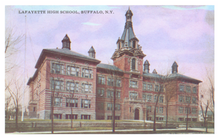
Currently, there are 78 public schools in the city including a growing number of charter schools. As of 2006, the total enrollment was 41,089 students with a student-teacher ratio of 13.5 to 1. The graduation rate is up to 52% in 2008, up from 45% in 2007, and 50% in 2006. More than 27% of teachers have a Master's degree or higher and the median amount of experience in the field is 15 years. When considering the entire metropolitan area, there are a total of 292 schools educating 172,854 students. Buffalo has a magnet school system, featuring schools that attract students with special interests, such as science, bilingual studies, and Native American studies. Specialized facilities include the Buffalo Elementary School of Technology; the Dr. Martin Luther King, Jr., Multicultural Institute; the International School; the Dr. Charles R. Drew Science Magnet School; Build Academy; Leonardo da Vinci High School Buffalo; PS 32 Bennett Park Montessori; the Buffalo Academy for the Visual and Performing Arts, BAVPA; the Riverside Institute of Technology; Lafayette High School/Buffalo Academy of Finance; Hutchinson Central Technical High School; Burgard Vocational High School; South Park High School; and the Emerson School of Hospitality.
Buffalo is currently in the process of a $1 billion city school rebuilding plan.
The city is home to 47 private schools while the metropolitan region has 150 institutions. Most private schools have a Roman Catholic affiliation. There are schools affiliated with other religions such as Islam. There are also nonsectarian options including The Buffalo Seminary (the only private, nonsectarian, all-girls school in Western New York state), and Nichols School.
Complementing its standard function, the Buffalo Public Schools Adult and Continuing Education Division provides education and services to adults throughout the community. In addition, the Career and Technical Education Department offers more than 20 academic programs, and is attended by about 6,000 students each year.
Listed below are institutions that have campuses in the city of Buffalo. Here is a complete list of all the colleges and universities in Western New York.
Buffalo is home to three State University of New York (SUNY) institutions. UB and Buffalo State are the largest institutions of their type in the system. The total enrollment of these 3 SUNY institutions combined is approximately 54,000 students in the area.
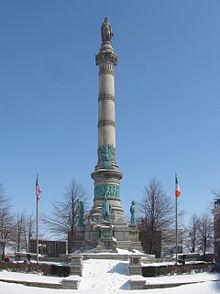
Buffalo and the surrounding area were long involved in railroad commerce, steel manufacture, automobile production, aircraft/aerospace design and production, Great Lakes shipping, and grain storage. Most of these industries have left the city through the years. Major steel production no longer exists in the area, although several smaller steel mills remain in operation. For example, Gibraltar Industries, a leading manufacturer, processor, and distributor of steel products for the building, industrial, and vehicular markets is headquartered in Buffalo. As of the 1950 United States Census, Buffalo was the 15th largest city in the country, the nation's largest inland port (twelfth overall), second biggest rail center, sixth largest steel producer, and eighth largest manufacturer.
The regional economy can now best be described as a mix of industrial, light manufacturing, high technology and service-oriented private sector companies. Instead of relying on a single industry or sector for its economic future, the region has taken a diversified approach that have the potential to create opportunities for growth and expansion in the 21st century.
On October 25, 2008 the United Nations released a report entitled "State of the World's Cities" in which the Buffalo-Niagara Falls area was specifically cited as having one of the worst rates of economic inequality in the world and that it was racially based. The report specifically stated "the report cited figures from western New York state, where 40 per cent of black, Hispanic and ethnically mixed households earned less than $15,000 in 1999, as compared to 15 per cent of white households." In addition, the United States Census department also released information placing the Buffalo-Niagara metro area, as the 8th most segregated area in America.
Overall, employment in Buffalo has shifted as its population has declined and manufacturing has left. Buffalo's 2005 unemployment rate was 6.6%, contrasted with New York State's 5.0% rate. And from the fourth quarter of 2005 to the fourth quarter of 2006, Erie County had no net job growth, ranking it 271st among the 326 largest counties in the country. Yet the area has recently seen an upswing in job growth as unemployment has dropped to only 4.9% in July 2007 from 5.2% in 2006 and 6.6% in 2005. The area's manufacturing jobs have continued to show the largest losses in jobs with over 17,000 fewer than at the start of 2006. Yet other sectors of the economy have outdistanced manufacturing and are seeing large increases. Educational and health services added over 30,400 jobs in 2006 and over 20,500 jobs have been added in the professional and business (mostly finance) arena.
Buffalo has increasingly become a center for bioinformatics and human genome research, including work by researchers at the University at Buffalo and the Roswell Park Cancer Institute. This consortium is known as the Buffalo Niagara Medical Campus. It also includes: Buffalo Hearing & Speech Center, Buffalo Medical Group Foundation, Hauptman-Woodward Medical Research Institute, Kaleida Health, Olmsted Center for the Visually Impaired, Cleveland BioLabs and Upstate New York Transplant Services. The DNA samples used in The Human Genome Project were also collected from anonymous donors from Buffalo.
Entrepreneurial resources and life science business consultants accelerate the growth and development of emerging companies found within the Buffalo Niagara Medical Campus and Upstate New York Region. For example, Buffalo BioSciences is a technology commercialization partner to the New York State Center of Excellence in Bioinformatics & Life Sciences and contributed to the launch and early success of Empire Genomics ae- a firm based on research conducted at Roswell Park Cancer Institute by Dr. Norma Nowak enabling the delivery of personalized medicine.

Buffalo is the headquarters of M&T Bank, a large regional bank with assets over $79B (as of June 2011). HSBC Bank USA also has major operations in Buffalo. Other banks, such as Bank of America and KeyBank have corporate operations in Buffalo. Citigroup also has regional offices in Amherst, Buffalo's largest suburb. Buffalo has also become a hub of the debt collection industry.
First Niagara Bank recently moved its headquarters to downtown Buffalo from nearby Lockport. First Niagara has branches from Buffalo to Albany, New York, and since September 2009 has had branches as far south as Pittsburgh. On September 10, 2009, First Niagara announced the relocation of its corporate headquarters from Lockport to downtown Buffalo. The company says facilities in Lockport will remain open and fully staffed. First Niagara, which had been considering expanding into Western Pennsylvania for some time, benefited from PNC Financial Services being required by the United States Department of Justice to sell off 50 National City branches in the Pittsburgh area and 11 more branches in and around Erie to competitors, since the two banks had significant overlap in Western Pennsylvania and had potential antitrust issues in that area. First Niagara took advantage by buying 57 of the 61 National City branches from PNC that had to be divested after PNC acquired National City with funds from the $700 billion bailout plan after National City became a victim of the subprime mortgage crisis. The move affected the area by creating 200 more jobs, some in the Buffalo area. On July 31, 2011, it was announced First Niagara had acquired all of HSBC Banks Western New York branches; after closing and selling some branches to its competitors its total number in Upstate New York had almost doubled.
Buffalo is home to Rich Products, one of the world's largest family-owned food manufacturers. Canadian brewer Labatt moved its US headquarters to Buffalo in May 2007. This is in large part due to Buffalo's location directly in the middle of the Northeastern Trade Corridor. The city is the heart of the Canadian-American corridor. Over 80% of all U.S.-Canada trade occurs via border crossings in the eastern United States and with five bridges to Canada, the Buffalo area is one of the key eastern border crossing locations. Cheese company Sorrento Lactalis is also based in Buffalo.
New Era Cap Company, the largest sports-licensed headwear company in the United States, is based in Buffalo. It opened new headquarters in 2007 in the former Federal Reserve Building in downtown Buffalo.
The windshield wiper maker Trico operated three major manufacturing facilities but has since closed all of them and moved operations to Mexico. In 1998, the company head office moved to Rochester Hills, Michigan.
For many years, Buffalo was the nation's second largest rail center, after Chicago. Peaked traffic reached during World War II, but declined soon after the war. Through the 1960s and 1970s freight traffic via Buffalo declined, air travel and the New York State Thruway took railway passengers away as well. By 1980, the rail hub in the city was gone.
Del Monte Foods' Milk Bone dog biscuits are still manufactured in a small factory on the city's East Side.
Regionally based insurance companies also have maintained their headquarters in Buffalo, New York. There aos Merchants Insurance Group and Lawley Insurance. Merchants Insurance Group is a property and casualty insurance company that provides commercial, personal property and casualty insurance throughout the Northeast and North Central United States. Lawley Insurance provides commercial insurance, employee benefits, risk management and personal insurance.
Delaware North Companies are headquartered in Buffalo.
According to the City's 2011 Comprehensive Annual Financial Report, the principal employers in the Buffalo Metropolitan Area as of June 30, 2011 are:
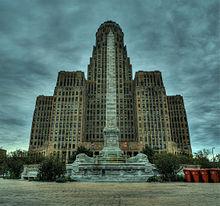
At the municipal level, the City of Buffalo has a mayor and a council consisting of nine councilmembers. Buffalo also serves as the seat of Erie County with some of the 11 members of county legislature representing at least a portion of Buffalo. At the state level, there are three state assemblymembers and two state senators representing parts of the city proper. At the federal level, Buffalo is represented by three members of the House of Representatives.
In a trend common to Northern "Rust Belt" regions, political life in Buffalo has been dominated by the Democratic Party for the last half-century, and has been roiled by racial division and social issues. The last time anyone other than a Democrat held the position of Mayor in Buffalo was 1965 [Chester A. Kowal]. In 1977, Democratic Mayor James D. Griffin was first elected as the nominee of two minor parties, the Conservative Party and the Right to Life Party, after he lost the Democratic primary for Mayor to then Deputy State Assembly Speaker Arthur Eve. Griffin switched political allegiance several times during his 14 years as Mayor, generally hewing to socially conservative platforms. His successor, Democrat Anthony M. Masiello (elected in 1993) continued to campaign on social conservatism, often crossing party lines in his endorsements and alliances. In 2005, however, Democrat Byron Brown was elected the city's first African-American mayor in a landslide (64%-27%) over Republican Kevin Helfer, who ran on a conservative platform.
This change in local politics was preceded by a fiscal crisis in 2003 when years of economic decline, a diminishing tax-base, and civic mismanagement left the city deep in debt and teetering on the edge of bankruptcy. At the urging of New York State Comptroller Alan Hevesi, the state took over the management of Buffalo's finances, appointing the Buffalo Fiscal Stability Authority. Conversations about merging the city with the larger Erie County government were initiated the following year by Mayor Tony Masiello, but came to naught.


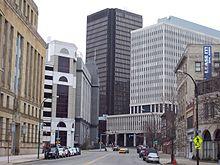
Buffalo consists of 32 different neighborhoods: (A map and listing of the neighborhoods from the University at Buffalo) Allentown, Bailey-Lovejoy, Black Rock, Central Park, Clinton-Bailey, Cold Springs, Delaware District, Downtown, East Side, Elmwood Village, Fillmore-Leroy, First Ward, Fruit Belt, Hamlin Park, Hospital Hill, Humboldt Park, Kaisertown, Kensington, Kensington Heights, Lower West Side, Masten Park, North Buffalo, North Park, Parkside, Polonia/Broadway Fillmore, Riverside, Schiller Park, South Buffalo, University District, University Heights, Vernon Triangle, Upper West Side, and Willert Park.
The American Planning Association named the Elmwood Village neighborhood in Buffalo one of ten Great Neighborhoods in 2007. Elmwood Village is a pedestrian-oriented, mixed use neighborhood with hundreds of small, locally owned boutiques, shops, restaurants, and cafes.
There are currently 9 common council districts in The City of Buffalo. They are: Delaware, Ellicott, Fillmore, Lovejoy, Masten, Niagara, North, South, and University.

One of Buffalo's many monikers is the City of Trees, which describes the abundance of green in the city. In fact, Buffalo has more than 20 parks with multiple ones being accessible from any part of the city.
The Olmsted Park and Parkway System is the hallmark of Buffalo's many green spaces. Three-fourths of city park land is part of the system, which comprises six major parks, eight connecting parkways, nine circles and seven smaller spaces. Begun in 1868 by Frederick Law Olmsted and his partner Calvert Vaux, the system was integrated into the city and marks the first attempt in America to lay out a coordinated system of public parks and parkways. The Olmsted designed portions of the Buffalo park system are listed on the National Register of Historic Places and are maintained by the Buffalo Olmsted Parks Conservancy.
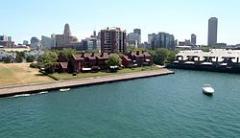
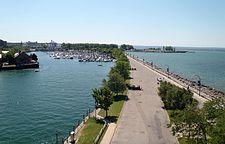
Situated at the confluence of Lake Erie and the Buffalo River and Niagara Rivers, Buffalo is a waterfront city. The city's rise to economic power came through its waterways in the form of transshipment, manufacturing, and an endless source of energy. Buffalo's waterfront remains, though to a lesser degree, a hub of commerce, trade, and industry.
As of 2009, a significant portion of Buffalo's waterfront is being transformed into a focal point for social and recreational activity. Recently excavated and rewatered is the Erie Canal Commercial Slip, which is the original western terminus of the Erie Canal System. This is intended to revitalize the original Erie Canal Harbor, with shops, eateries, and high-rise condominiums. Buffalo's intent is to stress its relatively architectural and historical heritage, creating a tourism destination.
The loss of traditional jobs in manufacturing, rapid suburbanization and high costs of labor have led to economic decline, making Buffalo one of the poorest amongst U.S. cities with populations of more than 250,000 people. An estimated 28.7-29.9% of Buffalo residents live below the poverty line, behind either only Detroit, or only Detroit and Cleveland. Buffalo's median household income of $27,850 is third-lowest among large cities, behind only Miami and Cleveland; however the median household income for the metropolitan area is $57,000.
This, in part, has led to the Buffalo-Niagara Falls metropolitan area having the most affordable housing market in the U.S. today. The quarterly NAHB/Wells Fargo Housing Opportunity Index (HOI) noted that nearly 90% of the new and existing homes sold in the metropolitan area during the second quarter were affordable to families making the area's median income of $57,000. The area median price of homes was $75,000.
Buffalo faces issues with vacant and abandoned houses, as the city ranks second only to St. Louis on the list of American cities with the most vacant properties per capita. Since 2000, the city has torn down 2,000 vacant homes but as many as 10,000 still remain. Mayor Byron W. Brown recently unveiled a $100 million, five-year plan to demolish 5,000 more houses. The city's move away from heavy industry and toward a service and bioinformatics economy has brought improved air and water quality, which benefit not only residents and tourists but the bioregion as a whole. In July 2005, Reader's Digest ranked Buffalo as the third cleanest large city in the nation.
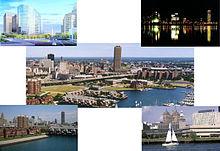
"The Queen City", Buffalo's most common moniker, first appeared in print in the 1840s, referring to the city's status as the second largest city in New York State after New York City. "The Queen City" was also used during the 19th century to describe Buffalo as the second largest American city on the Great Lakes after Chicago. Buffalo has also been called The Nickel City due to the appearance of a bison on the back of Indian Head nickel in the early part of the 20th century. The City of Good Neighbors refers to the helpful, friendly spirit of its inhabitants. In the early 20th century, the city began calling itself the City of Light both because of the plentiful hydroelectric power made possible by nearby Niagara Falls and because it was the first city in America to have electric street lights.
Buffalo was first settled primarily by New Englanders. The first wave of European immigrants was a large influx of Germans. The city was further populated by Irish immigrants first, Erie Canal builders and then escaping famine, and infused by Polish, Italian, Jewish, and more recently Latino populations, all of which have made it a melting pot of ethnic cultures. The newest immigrants are from Somalia, Sudan and Asia.
The Old First Ward retains a strong Irish identity, and Kaisertown reflects a German heritage. Buffalo's Polonia is centered at the Broadway Market on the East Side. The market serves as a microcosm of Polish/Slavic traditions and delicacies. The East Side is now home to African Americans, many of whom came north during the Great Migration. The annual Juneteenth Festival is a large cultural celebration organized by African Americans in Dr. Martin Luther King, Jr. Park.
The West Side is home to the city's Hispanic community, predominantly of Puerto Rican descent. The West Side was once Buffalo's "Little Italy," but in the 1980s much of Buffalo's Italian American community moved to North Buffalo. There is also a small Italian-American enclave in the East Side neighborhood of Lovejoy. Many Buffalo households, churches, and restaurants continue to observe the Sicilian custom of preparing St. Joseph's Day (March 19) tables, at which various meatless Lenten courses are laid out for the poor.
Buffalo is also home to a large Jewish community. German Jewish immigrants originally settled on Buffalo's Westside in the mid-19th century. Lower income Russian Jews and Polish Jews immigrating to the Niagara Frontier in the early 20th century initially settled on the Lower East Side, near William Street and Jefferson Avenue. The community migrated to the Masten Park neighborhood on the East Side, and then to North Buffalo between the 1940s and the 1960s. Although many still live in the city, particularly in North Buffalo and the Delaware District on the city's Westside, the majority of the Buffalo area's Jews now live in the northeastern suburbs. Buffalo's Jewish Community centers are located in the Delaware District, North Buffalo and Amherst.
Distancing itself from its industrial past, Buffalo is redefining itself as a cultural, banking, educational, medical center and architectural tourism destination. In 2001 USA Today named Buffalo the winner of its "City with a Heart" contest. proclaiming it the nation's "friendliest city." Buffalo is also a two-time winner of the All-America City Award.


As a melting pot of cultures, cuisine in the Buffalo area reflects a variety of influences. These include Italian, Irish, Jewish, German, Polish, African American, Greek, Indian and American influences. Beef on weck sandwich, Wardynski's kielbasa, Sahlen's hot dogs, sponge candy, pastry hearts, pierogi, and haddock fish fries are among the local favorites, as is a loganberry-flavored beverage that remains relatively obscure outside of the Western New York and Southern Ontario area. Weber's mustard is a well-known local producer of horseradish mustard, which is popular in the Western NY area. Teressa Bellissimo, the chef/owner of the city's Anchor Bar, first prepared the now-widespread chicken wings here on October 3, 1964. Thousands of Western New Yorkers descend into the city for food festivals during the summer months, such as the Taste of Buffalo and the National Buffalo Wing Festival. There are also festivals themed around ethnic cuisines such as the Italian, Hellenic and Lebanese festivals.
Local or regional chains with a significant presence in the Buffalo area include Louie's Hot Dogs, Ted's Hot Dogs, Anderson's Frozen Custard, John and Mary's Submarines, Duff's Famous Wings, Jim's Steakout, Just Pizza, SPoT Coffee, Tim Hortons, Mighty Taco, Leonardi's, Bocce Club and La Nova Pizzeria. Buffalo's pizza is unique. Perhaps because Buffalo is geographically located halfway between New York City and Chicago, Illinois, the pizza made is likewise about halfway between thin-crust New York-style pizza and deep-dish Chicago-style pizza.
The city is home to the Pearl Street Brewery and Flying Bison Brewing Company, who continue Buffalo's brewing traditions. Labatt USA, the US operation for Labatt Beer, a Canadian brewer, is headquartered in Buffalo.
Buffalo has several specialty import/grocery stores in old ethnic neighborhoods, and is home to an eclectic collection of cafes and restaurants that serve adventurous, cosmopolitan fare. Locally owned restaurants offer Chinese, German, Japanese, Korean, Vietnamese, Thai, Mexican, Italian, Greek, Arab, Indian, Caribbean, Soul food, and French.
Several well-known food companies are based in Buffalo. Non-dairy whipped topping, later imitated by Cool Whip, was invented in Buffalo in 1945 by Robert E. Rich, Sr. His company, Rich Products, is one of the city's largest private employers. General Mills was organized in Buffalo, and Gold Medal brand flour, Wheaties, Cheerios and other General Mills brand cereals are manufactured here. One of the country's largest cheese manufacturers, Sorrento, has been here since 1947. Archer Daniels Midland operates its largest flour mill in the city. Buffalo is home to one of the largest privately held food companies in the world, Delaware North Companies, which operates concessions in sports arenas, stadiums, resorts, and many state & federal parks.
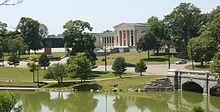
Buffalo is home to over 50 private and public art galleries,[100] most notably the Albright-Knox Art Gallery, home to a world-class collection of modern and contemporary art. The local art scene is also enhanced by the Burchfield-Penney Art Center, Hallwalls Contemporary Arts Center, CEPA Gallery, and many small galleries and studios.[101][102] AmericanStyle ranked Buffalo fourth in its list of America's top art destinations.
Two street festivals ae the Allentown Art Festival and the Elmwood Festival of the Arts ae bring thousands of people to the city to browse and purchase original crafts. The Buffalo Philharmonic Orchestra, which performs at Kleinhans Music Hall, is one of the city's most prominent performing arts institutions. In the 1960s and 1970s, under the musical leadership of Lukas Foss and Michael Tilson Thomas, the Philharmonic was generally regarded as the leading orchestra in the US for new music. Shea's Performing Arts Center, long known as Shea's Buffalo, is an 1920s movie palace that continues to show productions and concerts. Its interior was designed by Louis Comfort Tiffany. Buffalo is also home to the second largest free outdoor Shakespeare festival in the United States, Shakespeare in Delaware Park. Filmmaker, writer, painter and musician Vincent Gallo was born in Buffalo in 1962 and lived there until 1978 when he moved out on his own to New York City.
Buffalo is also the founding city for several mainstream bands and musicians, most famously Rick James, Billy Sheehan and The Goo Goo Dolls. Vincent Gallo, Buffalo-born filmmaker and musician, played in several local bands. Jazz fusion band Spyro Gyra also got its start in Buffalo. Well-known indie artist Ani DiFranco hails from Buffalo, and it is the home of her "Righteous Babe" record label. 10,000 Maniacs are from nearby Jamestown, but got their start in Buffalo, which led to lead singer Natalie Merchant launching a successful solo career. Death Metal band Cannibal Corpse reached national fame in 1994 when they appeared in the movie Ace Ventura: Pet Detective, at the request of lead actor Jim Carrey. The director agreed and decided to actually have Jim jump on stage with the band and start singing a song of theirs in the film to escape two pursuing goons. Other bands include Every Time I Die, Snapcase, Malevolent Creation and moe. also started off in Buffalo. Power Pop/Indie Punk Trio, Lemuria also derive from Buffalo. Dark Bluud, most notably associated with Juggalos and the underground scene, got his start in Buffalo. Several Hip-Hop artists also founded in Buffalo include group Joe Public, and rapper Chae Hawk.
Buffalo has a vibrant theatre community, with over 20 professional companies. Major theatres groups include The Alt at the Warehouse, American Repertory Theater of Western New York, Brazen Faced Varlets, The Irish Classical Theatre, The Kavinoky Theatre, Lancaster Opera House, The New Phoenix Theatre, Road Less Traveled Productions, Shea's Performing Arts Center, The Subversive Theatre, The Theatre of Youth, and Torn Space Theatre. These companies present a variety of theatre styles and many present original productions by Buffalo playwrights. Each year, the weekly publication ArtVoice sponsors The Artie Awards, celebrating the year in theatre by recognizing top shows and performances. Scores of performers have honed their skills in the Buffalo Theatre Community and have gone on to successful careers in the industry.

The New York Times has declared that Buffalo is one of the top cities in America for architecture. Approximately 80 sites are included on the National Register of Historic Places. All of the major American architects of the 19th and early 20th century built masterpieces in Buffalo, most of which are still standing. They include:
The country's largest intact parks system designed by Frederick Law Olmsted and Calvert Vaux, including Delaware Park. Buffalo was the first city for which Olmsted designed (in 1869) an interconnected park and parkway system rather than stand-alone parks.
The Guaranty Building, by Louis Sullivan, was one of the first steel-supported, curtain-walled buildings in the world, and its 13 stories made it, at the time it was built (1895), the tallest building in Buffalo and one of the world's first true skyscrapers.[103] It is a National Historic Landmark.
The Hotel Buffalo (originally the Statler Hotel) by August Esenwein and James A. Johnson was the first hotel in the world to feature a private bath in each room.
The H. H. Richardson Complex, originally the New York State Asylum for the Insane, is Richardsonian Romanesque in style and was the largest commission designed by prominent architect Henry Hobson Richardson. The grounds of this hospital were designed by Olmsted. Though currently in a state of disrepair, New York State has allocated funds to restore this treasure.
There are several buildings by Frank Lloyd Wright, including the Darwin D. Martin House, George Barton House, William R. Heath House, Walter V. Davidson House, The Graycliff Estate, as well as the now demolished Larkin Administration Building.[104][105] Constructed in 2007 on Buffalo's Black Rock Canal is a Wright-designed boathouse originally intended, but never built, for the University of Wisconsin aeMadison rowing team. Along as a tourist destination, it functionally serves many Buffalo-area rowing teams belonging to the West Side Rowing Club. Buffalo has more Frank Lloyd Wright buildings than any other city except Chicago.
The Buffalo City Hall building by George Dietel and John J. Wade is a spectacular art deco skyscraper and is listed on the National Register of Historic Places.
Other notable buildings:
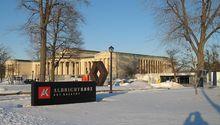

Buffalo City Hall building's art deco

Darwin D. Martin House by Frank Lloyd Wright

Kleinhans Music Hall by Eliel and Eero Saarinen

Buffalo and Erie County Historical Society

Erie County Hall

Asbury Delaware Church

Buffalo Central Terminal

Electric Tower
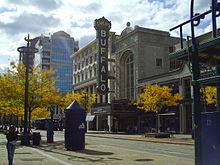
Last call is at 4 a.m. in Buffalo, rather than 2 a.m. as in most other areas of the U.S. This is often attributed to the historically high density of industrial facilities and the demand of second and third shift patrons. It is also because New York law allows bars to be open until 4 a.m. (However, local municipalities can override it to an earlier time.)
Several distinct and thriving nightlife districts have grown around clusters of bars and nightclubs in the city. The most visible nightlife district is West Chippewa Street,[107] located between Main Street and South Elmwood Avenue. The area is home to high-energy dance clubs, crowded bars, trendy coffeehouses, and restaurants. Allentown, where bars are as numerous but the atmosphere is a bit more relaxed, is a several minute walk north to Allen Street. Allen Street near Main Street houses several bars, while Allen near Elmwood has many bars that feature live music. Continuing up Elmwood Avenue from Allentown is the Elmwood Strip, which runs about two miles (3 km) to Buffalo State College. This strip has numerous small boutiques and restaurants, with few large corporate establishments. Crowds on this strip include everyone from college students to families to the elderly.
Like many large cities, numerous festivals have become part of the city's culture and tradition. Though most of the festivals occur during the summer months, the city has recently pushed efforts to have winter festivals as well in an effort to capitalize on the region's snowy reputation.
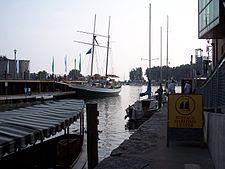
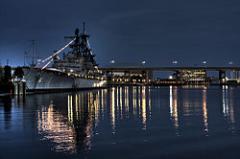
Buffalo is served by the Buffalo Niagara International Airport, located in Cheektowaga. The airport, recently re-constructed, serves over 5 million passengers a year and is still growing. Buffalo Niagara International Airport ranks among the five cheapest airports from which to fly in the country, according to the U.S. Bureau of Transportation Statistics. The average round trip flight cost is $295.58.[113] In the last few years there has been a surge in Canadians flying out of Buffalo, mainly due to much cheaper tax and airline surcharges, as compared with Canadian airports and the ability to fly on some US based discount carriers not available in Canada (for example, JetBlue Airways and Southwest Airlines). As of 2006, plans are in the works by U.S. Senator Charles Schumer to make the under-used Niagara Falls International Airport into an international cargo hub for New York and Toronto, as well as Canada as a whole.[114]
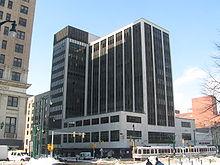
The Niagara Frontier Transportation Authority (NFTA) operates Buffalo Niagara International Airport and Niagara Falls International Airport, and the public transit system throughout the Buffalo area. The NFTA operates bus lines throughout the city and suburbs, as well as the Metro Rail transit system in the city.
The Metro Rail is a 6.4 miles (10.3 km) long, single line light rail system that extends from Erie Canal Harbor in downtown Buffalo to the University Heights district (specifically, the South Campus of University at Buffalo) in the northern part of the city. The downtown section of the line runs above ground and is free of charge to passengers. North of Theater Station, at the northern end of downtown, the line moves underground, remaining underground until it reaches the northern terminus of the line at University Heights. Passengers pay a fare to ride this section of the rail.
A new NFTA project is underway, often called "Cars on Main Street", that will substantially revise the downtown portion of the Metro Rail. It will allow vehicular traffic and Metro Rail cars to share Main St. in a manner similar to that of the trolleys of San Francisco. The design includes new stations and pedestrian-friendly improvements. The first phase of the project, restoring two way traffic on Main Street between Edward and West Tupper, was completed in 2009. When the entire project is complete in the next few years, the downtown portion of Main St. will be re-opened to vehicular traffic for the first time in almost 30 years.
Two train stations, Buffalo-Depew and Buffalo-Exchange Street serve the city and are operated by Amtrak.
Freight service for Buffalo is served by CSX Transportation and Norfolk Southern (NS), as well as Canadian National (CN) and Canadian Pacific (CP) railroads from across the Border. The area has 4 large rail yards: Frontier (CSX), Bison (NS), SK (NS / CP) and Buffalo Creek (NS / CSX). A large amount of hazardous cargo also crosses through the Buffalo area, such as liquid propane and anhydrous ammonia.
Buffalo is at the eastern end of Lake Erie, one of the Great Lakes, which boasts the greatest variety of freshwater sportfish in the country. The Lake serves as a playground for numerous personal yachts, sailboats, power boats and watercraft. The city has an extensive breakwall system protecting its inner and outer Lake Erie harbors, which are maintained at commercial navigation depths for Great Lakes freighters.
A Lake Erie tributary that flows through south Buffalo is the Buffalo River, for which the city is named. Buffalo is historically linked to the fabled Erie Canal, which ends where the Black Rock Channel enters Lake Erie. When the Canal was dedicated in 1825, its conceiver, New York State governor DeWitt Clinton took waters from Lake Erie at Buffalo's Western Terminus of the Canal (now the Commercial Slip). He sailed to New York City on the Canal packet Seneca Chief, which later returned to Buffalo with Atlantic Ocean water. The seawater was poured into the Lake by Judge and future Buffalo Mayor Samuel Wilkeson. Once a major route for passengers and cargo, the Canal is now used primarily for pleasure craft and some light local freight, and in Buffalo it bypasses the swift upper reach of the Niagara River. A tributary of the Niagara River is Scajaquada Creek, which flows though Buffalo, via the Frederick Law Olmsted-designed Delaware Lake and Park.
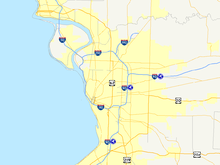
The offices of the Buffalo District, US Army Corps of Engineers are located adjacent to the Black Rock Lock in the Black Rock channel of the Erie Canal. In addition to maintaining and operating the lock, the District is responsible for planning, design, construction and maintenance of water resources projects in an area extending from Toledo, Ohio to Massena, New York. These include the flood-control dam at Mount Morris, New York, oversight of the lower Great Lakes (Erie and Ontario), review and permitting of wetlands construction, and remedial action for hazardous waste sites.
Buffalo is also the home of a major office of the National Weather Service (NOAA), which serves all of western and much of central New York State.
Buffalo is home to one of the 56 national FBI field offices. The field office covers all of Western New York and parts of the Southern Tier and Central New York. The field office operates several task forces in conjunction with local agencies to help combat issues such as gang violence, terrorism threats and health care fraud.[115]
Buffalo is also the location of the chief judge, United States Attorney, and administrative offices for the United States District Court for the Western District of New York.
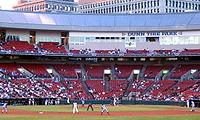
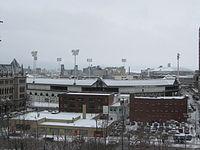

* Championships listed are American Football League championships, not NFL championships.
Buffalo has a number of sister cities as designated by Sister Cities International (SCI):[116][117]
Buffalo also has partnerships with the following towns:[126]
While there is no formal relationship, Buffalo and Toronto enjoy a close link and friendly rivalry.
Honorary Consulates:

Word Count: 9934






